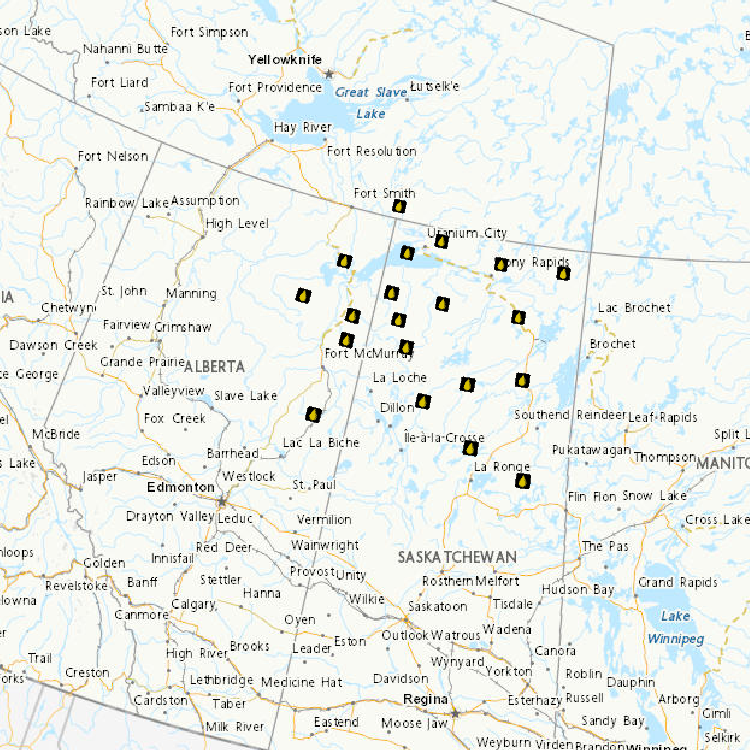Territories - Northwest Territories (NT)
Type of resources
Available actions
Topics
Keywords
Contact for the resource
Provided by
Formats
Representation types
Update frequencies
status
-

Acid-Sensitive Lakes Nine hundred and thirty-three lakes located in Saskatchewan, Alberta and the Northwest Territories were sampled to establish current acidification status. Of the 933 lakes, 244 (or 26%) are considered acid sensitive, almost always because of naturally low calcium and magnesium (or "base cation") concentrations. The most acid-sensitive lakes (i.e., those with extremely low base cation concentrations) are located on the Canadian Shield in both Alberta and Saskatchewan and east of the oils sands development area. Fifty-one of the 244 acid-sensitive lakes were sampled twice annually (spring and fall) to identify chemical changes through trend analyses. Results revealed that 55% of these lakes had concentrations of some metals in excess of Canadian Council of Ministers of the Environment guidelines. Of the 291 samples taken in the 51 lakes, iron concentrations were greater than guidelines in 36% (105 samples), aluminum in 33% (97 samples), lead in 0.3% (1 sample) and copper in 0.3% (1 sample). The metals in these lakes occur naturally and are expected to be found in a wide range of concentrations given the geology and physiography of the Canadian Shield. It remains to establish the relationship between acid sensitivity, geology and high metal concentrations.
-
Assess the importance of atmospheric deposition of contaminants as a contributor to ecological impacts of oil sands development and identify sources. • Use snowpack measurements sampled across a gridwork to develop maps of winter-time atmospheric contaminant loadings for the region ~100 km from the major upgrading facilities • Assess long-term trends in winter-time atmospheric deposition • Determine the potential impact of wintertime snowpack mercury loads on tributary river water mercury concentrations (Spring Freshet) using Geographic Information System and hydrological modelling approaches • Compare snowpack loadings to those obtained from precipitation monitoring and compare spatial patterns to PAC air measurements obtained from passive sampling network
-
Multi-model ensembles for a suite of variables based on projections from Coupled Model Intercomparison Project Phase 6 (CMIP6) global climate models (GCMs) are available for 1850-2100 on a common 1x1 degree global grid. Climate projections vary across GCMs due to differences in the representation and approximation of earth systems and processes, and natural variability and uncertainty regarding future climate drivers. Thus, there is no single best climate model. Rather, using results from an ensemble of models (e.g., taking the average) is best practice, as an ensemble takes model uncertainty into account and provides more reliable climate projections. Provided on Canadian Climate Data and Scenarios (CCDS) are four types of products based on the CMIP6 multi-model ensembles: time series datasets and plots, maps and associated datasets, tabular datasets, and global gridded datasets. Monthly, seasonal, and annual ensembles are available for up to six Shared Socioeconomic Pathways (SSPs) (SSP1-1.9, SSP1-2.6, SSP2-4.5, SSP3-7.0, SSP4-6.0, and SSP5-8.5), four future periods (near-term (2021-2040), mid-term (2041-2060 and 2061-2080), end of century (2081-2100)), and up to five percentiles (5th, 25th, 50th (median), 75th, and 95th) of the CMIP6 ensemble distribution. The number of models in each ensemble differs according to model availability for each SSP and variable, see the model list resource for details on the models included in each ensemble. The majority of products show projected changes expressed as anomalies according to a historical reference period of 1995-2014. The products provided include global, national, and provincial/territorial datasets and graphics. For more information on the CMIP6 multi-model ensembles, see the technical documentation resource.
 Arctic SDI catalogue
Arctic SDI catalogue